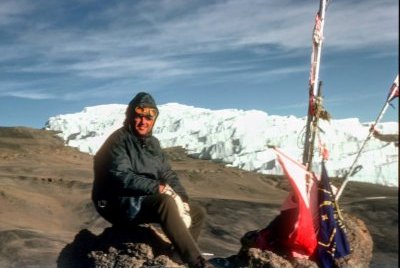
If you have just viewed this WHS from “ground level” in Amboseli Park or from Arusha why not try climbing it? It is possible for anyone who is reasonably fit and does a bit of mental and physical preparation.
I did it back in 1974 but no doubt it will be much busier, more commercialised and costly now. In those days there was only 1 route – from Marangu. But now there are many to choose from. I can’t therefore comment on which is better. The Marangu is the “classic”, and has huts (whereas the others require camping) but uses the same route up and down whereas others provide some variety! I turned up at the Marangu hotel and made up a group with 4 other tourists there. The hotel arranged the porters etc. I see from the web site that the hotel is still there offering the same services (though the English colonial ladies who ran it on those days have no doubt passed on unfortunately). It is certainly pleasantly located for a stay before and after and possibly more so than a hotel in Arusha or Moshi. We went up without hut bookings but I doubt that that is possible nowadays. Even then the middle hut (Horombo) got over-full as it alone is used on the upward and downward route.
Each day passes through different country – forest, savannah and high mountain desert. The Giant Lobelia and other unique botanical species are a highlight of the walk together with the views and the understanding you gain of the enormous bulk of this mountain. Although there are animals in the park you are not likely to see much other than birds. The final day’s climb from Kibo hut is traditionally started very early so that arrival at the rim (Gilman’s Point) is achieved in time for sunrise and before the views across to Mawenzi are obscured by the clouds which soon build up. This also leaves time to walk round to the summit at Uhuru Peak on a snow covered path looking down into the glaciers and ice needles in the crater – if you are up to it! (Though I understand that "global warming" across the years since my 1974 climb might have removed most of the ice and snow)
Estimates of the success rates vary - some say as low as 30% others up around 80% to Gilmans point but lower to Uhuru. It is certainly true that many will be forced to give up - particularly on the final morning climb from Kibo. Of our 5 only 3 of us made it to Gilmans and we all went on to Uhuru. Those who gave up suggested that they had not entered the task with the right degree of commitment, having decided to do the climb whilst passing through Tanzania on an Africa trip. First of all, given the cost and commitment you are going to have to face it is worth ensuring you are as fit as you can be before you go, but altitude sickness can hit anyone however fit – and there is little chance to acclimatise on this trip. You can arrange an extra night at Horombo but some might believe that only gives you more chance of getting sick! Be very careful with your diet – I took my own supplements and avoided some of the prepared meals – you climb on your stomach and you need energy not lots of bulk! Also only drink filtered water and remember that, at altitude hot tea and coffee are probably not properly boiled. We learned 2 words of Swahili which helped with success :-
“Twende” –“Lets go” - this after the frequent rest stops. It is not a race. There is more than enough time each day to get between the huts so you might as well have plenty of rest stops!
“Polepole” – “Slowly”. If you are breathing heavily you are going too fast/hard!
So “Go for it!” and good luck!
More on
Comments
No comments yet.
